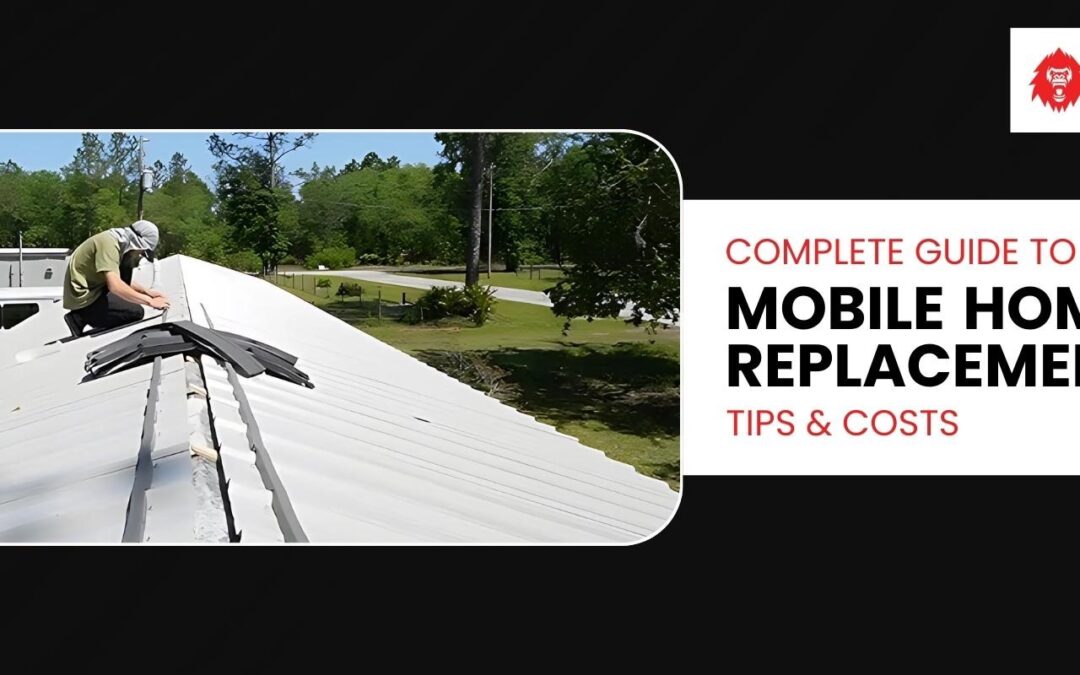Owning a mobile home comes with the responsibility of maintaining its roof. Over time, roofs can wear down due to weather, age, and external factors, requiring mobile home roof replacement. This comprehensive guide will walk you through the process, covering the costs, materials, and solutions available to help you make an informed decision. If you’re looking for long-lasting and cost-effective roof solutions, this guide is for you.
Roof Damage and Its Impact
A damaged roof on a mobile home can lead to serious issues such as leaks, structural damage, and energy inefficiency. When left unaddressed, these problems can worsen, causing significant financial strain. Unfortunately, many mobile homeowners don’t realize how crucial it is to replace their roofs before the damage becomes severe.
The cost of home roof replacement varies, but it’s a necessary investment for long-term home maintenance. Ignoring the signs of a deteriorating roof can lead to costly repairs down the line. If you’re noticing leaks, sagging, or missing shingles, it’s time to consider a roof replacement.
Why You Need to Consider Mobile Home Replacement of Roofs?
Mobile homes often have unique roofing systems compared to traditional houses. The roofs are typically flatter, which can lead to water pooling and quicker wear. Since they’re exposed to various weather conditions—rain, snow, wind, and sun—it’s essential to use high-quality materials that can withstand these elements.
If you’re dealing with frequent repairs or an outdated roofing system, it’s time to replace your roof. Mobile home roof replacement offers several benefits:
- Improved Energy Efficiency: New roofing materials can help regulate temperature, reducing heating and cooling costs.
- Protection from Weather: A new roof will better protect your home from water damage, leaks, and storms.
- Increased Property Value: A new roof boosts the overall value of your home, especially if you plan to sell in the future.
Common Mobile Home Roof Types and Replacement Options
When replacing your mobile home roof, it’s crucial to understand the available roofing options. Different materials and styles work best for various climates, budgets, and aesthetic preferences. Here are some common types of mobile home roofs:
1. Metal Roofing
Metal roofing is one of the most popular roof solutions for mobile homes. It’s durable, fire-resistant, and low-maintenance. Additionally, it reflects heat, which helps with energy efficiency.
- Pros: Long-lasting, low maintenance, resistant to harsh weather
- Cons: Higher upfront cost compared to other materials
2. Rubber Roofing (EPDM)
Rubber roofing, or EPDM (ethylene propylene diene monomer), is a popular option due to its affordability and ease of installation. It’s particularly effective in areas with frequent rainfall.
- Pros: Cost-effective, lightweight, flexible, and water-resistant
- Cons: May need frequent repairs depending on the climate
3. Shingle Roofing
Shingle roofs, like those found on traditional homes, are another option for mobile homes. Asphalt shingles are commonly used and are relatively easy to install.
- Pros: Affordable, available in various styles and colors
- Cons: Not as durable in extreme weather conditions
4. TPO Roofing
TPO (Thermoplastic Olefin) is another option for mobile homes, made from a single-ply membrane. It’s energy-efficient and UV-resistant, making it an ideal choice for hot climates.
- Pros: Energy-efficient, heat-resistant, low-maintenance
- Cons: Installation can be more complex, higher initial costs
Steps to Mobile Home Roof Replacement
The process of replacing your mobile home roof may seem daunting, but by following the right steps, it can be smooth and stress-free. Here’s a breakdown of the process:
1. Inspection and Assessment
Start by having a professional inspect your current roof. They will assess the damage and provide you with a clear estimate for replacement. If your roof has minimal damage, you may only need repairs. However, if your roof is old or severely damaged, a full replacement is recommended.
2. Choosing the Right Materials
Once the inspection is complete, it’s time to choose the right roofing materials for your mobile home. Consider your budget, the local climate, and the aesthetic you want. Your roofing contractor can guide you toward the best roof solutions for your needs.
3. Removal of the Old Roof
In most cases, the old roof will need to be removed before the new roof can be installed. This step is crucial for ensuring that the new roof is properly installed and secured.
4. Installation of the New Roof
After the old roof is removed, the new materials will be installed. Depending on the material, this can take anywhere from a few days to a week.
5. Final Inspection
Once the new roof is installed, the contractor will perform a final inspection to ensure everything is up to code. They’ll check for leaks and confirm the roof is secure.
Roof Solutions for Long-Lasting Results
Choosing the right roof solutions is crucial for ensuring that your roof lasts for many years. Quality materials, proper installation, and routine maintenance will extend the life of your mobile home roof and save you money on repairs in the future.
Conclusion
If you’re dealing with roof damage or an aging roof, home roof replacement is a smart investment. Not only will a new roof protect your home from the elements, but it will also increase your home’s value and energy efficiency. By carefully considering your roofing options and choosing the right materials, you can ensure that your new roof will last for years to come.
Whether you need roof solutions for aesthetic purposes or to improve the protection and value of your mobile home, there are plenty of affordable and reliable options. Contact a professional today to discuss your mobile home roofing needs.
Ready to replace your mobile home roof? Get in touch with us today for the best mobile home roof replacement options, and let us help you find the right solutions for your home!

